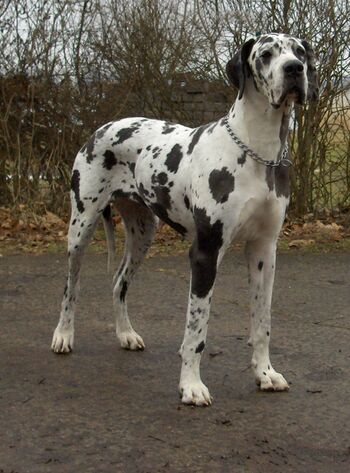Great Dane
The Great Dane is a large breed of dog. It is the tallest of the working breeds, with males standing no less than 30 inches (76 cm) at the top of the shoulders and females at least 28 inches (71 cm); it weighs 120 to 150 pounds (54 to 68 kg). A Great Dane called 'Gibson' is currently the world's tallest living dog, according to the Guiness Book of World Records.
Classed as a member of the 'working group' by the Kennel Club (Great Britain) and as a 'working dog' by the American Kennel Club, its name is derived from "the old French designation, grand Danois, meaning Big Danish"(ref Great Dane in The Complete Dog Book page 271). George Buffon, an eighteenth century French naturalist, used this name in describing the breed, and the English speaking world has since used its translation. "The German, however, use the name Deutsche Dogge (German Mastiff), which is closer to the truth, because the present day dog was developed by German breeders during the nineteenth century. The Great Dane was first displayed at a Hamburg dog show in 1862."(Great Dane in Book of Dogs page 162)
Appearance
Great Danes are recognized in the following colors and patterns: Colours:
- Blue
- Black
- Fawn
Patterns:
- Brindle
- Harlequin
- Mantle
Cropping
There are two acceptable fashions for a Great Dane's ears. They may be left natural, as the harlequin Dane's ears are shown in the photograph to the right. Some breeders prefer to crop their puppies' ears. The ears will stay erect, but must be taped in position for the first several months of the pup's life in order to do so reliably.
Health concerns
Each purebred dog has particular health problems that are more common in its breed than in others. Some of these concerns are due to recessive genes that are more likely to "show" in animals that come from related ancestors. Other problems are simply associated with the typical physical features characteristic of a breed. Great Danes are more likely to suffer difficulties, such as "bloat", that are associated with being very large.
